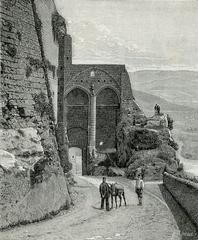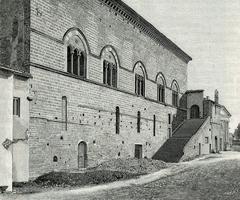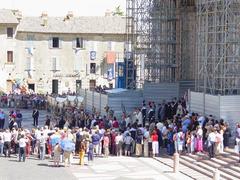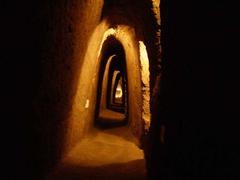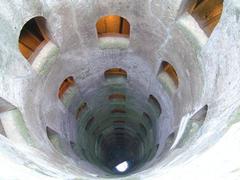Castello di Tordimonte: Visiting Hours, Tickets, and Your Guide to Orvieto’s Historical Heritage
Date: 14/06/2025
Introduction
Perched amid the rolling hills south of Orvieto, Castello di Tordimonte is a testament to Umbria’s layered history, fusing medieval fortification with Renaissance refinement and a vibrant tradition of rural stewardship. Overlooking the Paglia River valley, the castle—whose name draws from the Latin “Turris Montis,” or “Tower of the Mountain”—has stood as a strategic outpost, noble residence, and symbol of the region’s evolving sociopolitical landscape since the 13th century. Today, although much of the estate remains private, the castle and its surroundings invite exploration, offering visitors an authentic window into Umbria’s past and present.
This comprehensive guide details Castello di Tordimonte’s origins, architectural evolution, historical and cultural significance, practical visitor advice—including up-to-date visiting hours and ticketing information—and tips for making the most of your journey to Orvieto and its historical sites. For updated information and further reading, refer to resources such as OrvietoViva, Mama Loves Italy, Strictly Italy, and Komoot.
Table of Contents
- Introduction
- Origins and Early History
- Architectural Evolution
- Historical and Cultural Significance
- Visiting Castello di Tordimonte: Hours, Tickets, and Tips
- Accessibility, Facilities, and Travel Advice
- Nearby Orvieto Historical Sites
- Responsible Tourism and Environmental Stewardship
- FAQ
- Conclusion and Call to Action
- References
Origins and Early History
The earliest records of Castello di Tordimonte date to the 13th century, when it functioned as a fortified watchtower overseeing the vital trade and pilgrimage routes that traversed the Paglia and Tiber river valleys. Constructed in response to ongoing territorial disputes, the castle’s hilltop position provided both defensive strength and a commanding view of the landscape, protecting local settlements and the agricultural wealth of the region (OrvietoViva).
Ownership of the castle shifted among prominent local families, including the Monaldeschi and Filippeschi, each contributing to its expansion and fortification. The castle’s foundation as a strategic bulwark was later complemented by its role as a rural noble residence.
Architectural Evolution
Castello di Tordimonte’s architecture reflects centuries of adaptation and transformation. Initially consisting of a central keep, curtain walls, and a small courtyard, the castle’s form evolved as military threats waned and the needs of its noble residents changed:
- Medieval Origins: Thick tufa stone walls, battlements, defensive towers, and arrow slits define the castle’s core, echoing the defensive strategies seen in Orvieto’s own city walls (Mama Loves Italy).
- Renaissance Modifications: As the region enjoyed greater stability, the castle was embellished with arched windows, decorative portals, frescoed interiors, and a private chapel. The estate expanded to include terraced gardens and more comfortable living quarters, blending the practical with the elegant (Strictly Italy).
- Modern Restoration: In the early 20th century, Earl Angelo Brazzetti commissioned architect Ugo Tarchi to restore and modernize the estate, introducing hydroelectric power, aqueducts, and agricultural facilities while preserving the castle’s historic fabric (Tordimonte Official Website).
The castle’s harmonious integration of architecture and landscape remains a defining feature, with panoramic terraces and “rasole” olive groves enhancing its visual appeal (Komoot).
Historical and Cultural Significance
Regional Power and Social Influence
Throughout the Middle Ages and Renaissance, Castello di Tordimonte was central to the defense and administration of the Orvieto territory. As both a military outpost and seat of noble authority, it oversaw vital agricultural lands, collected rents, and played a role in local governance.
Noble Lineages and Restoration
The castle’s history is intertwined with the fortunes of noble families such as the Bovacciani-Montemarte, Monaldeschi, Piccolomini Clementini, and Brazzetti. The Brazzetti family’s restoration efforts in the 20th century, combined with ongoing agricultural production, have preserved both the castle’s structure and its role as a living heritage site (Azienda Vittori Marialuce).
Cultural Traditions
While the castle itself does not typically host public events, the estate’s award-winning wines and olive oils are central to Umbria’s gastronomic culture. The surrounding region is celebrated for festivals, local produce, and vibrant community traditions (Salt in Our Hair).
Visiting Castello di Tordimonte: Hours, Tickets, and Tips
Public Access and Hours:
Castello di Tordimonte remains primarily a private estate and does not offer regular public tours or fixed visiting hours. However, the castle can be admired from public trails and scenic viewpoints. Occasionally, special events or private visits may be arranged by contacting the estate directly (Tordimonte Official Website).
Tickets and Admission:
There is no standard entrance fee, as the castle is not generally open to the public. Tickets may be required for special guided tours or events, typically priced between €5 and €10 (The Tourist Checklist).
Guided Tours:
Guided tours are not routinely available but may be arranged by appointment during select events. Nearby castles such as Castello della Sala offer regular tours and tastings (OrvietoViva).
Accessibility, Facilities, and Travel Advice
Getting There:
- By Car: Approximately a 15-minute drive south of Orvieto. Follow the SP44 or local roads toward Tordimonte. Limited parking is available near the castle.
- By Bicycle/Walking: The castle is accessible via regional cycling and hiking routes, offering panoramic views and a chance to explore the surrounding countryside (Komoot).
- Public Transport: No direct public transport is available; taxis or private transfers are recommended from Orvieto.
Facilities:
- Restrooms & Food: Facilities are minimal. Use amenities in Orvieto before arrival and bring water/snacks. Picnicking is permitted in designated areas.
- Accessibility: The terrain is uneven and includes steep paths, making access challenging for those with limited mobility.
- Pets: Dogs on leashes are generally welcome on the grounds; interior access may be restricted.
Photography:
The castle’s central tower, olive groves, and hilltop vistas are ideal for photography, especially at sunrise or sunset.
Nearby Orvieto Historical Sites
Enhance your visit by exploring Orvieto’s celebrated landmarks:
- Duomo di Orvieto: Renowned for its Gothic façade and frescoes.
- Torre del Moro: Offers sweeping city views.
- Pozzo di San Patrizio: An ingenious Renaissance well.
- Castello della Sala: Another historic castle with guided tours and tastings (OrvietoViva).
- Cycling and Hiking Trails: The area is woven with routes connecting castles, vineyards, and Etruscan sites (Komoot).
Responsible Tourism and Environmental Stewardship
Respect the estate by staying on marked trails, not disturbing wildlife, and carrying out any litter. Supporting local producers by purchasing wines and olive oils helps preserve Umbria’s rural traditions and sustainable agriculture (Tordimonte Official Website).
Frequently Asked Questions (FAQ)
Q: What are the visiting hours for Castello di Tordimonte?
A: There are no regular visiting hours; the castle is private, but views are accessible from public trails.
Q: Is there an entrance fee?
A: No standard fee; tickets may be required for special events or pre-arranged tours.
Q: How do I get there from Orvieto?
A: By car (15 minutes), bicycle, or on foot via scenic routes.
Q: Are guided tours available?
A: Only occasionally by appointment; nearby castles offer regular tours.
Q: What should I bring?
A: Sturdy shoes, water, sun protection, and a camera.
Conclusion and Call to Action
Castello di Tordimonte is a compelling fusion of medieval heritage, noble tradition, and sustainable rural life, offering a unique vantage point on Umbria’s storied landscape. While regular public access is limited, the estate’s scenic beauty, historic resonance, and proximity to Orvieto’s treasures make it a rewarding destination for informed and respectful visitors. Plan your journey with current visiting details, explore the region’s castles, and support local artisans to fully immerse yourself in the spirit of Umbria.
Ready to discover Castello di Tordimonte and Orvieto’s historical gems?
Download the Audiala app for personalized guides, interactive maps, and insider tips. Follow us on social media for updates on events and sustainable travel inspiration.
